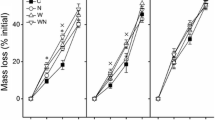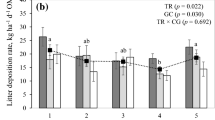Abstract
Human management practices and large detritivores such as earthworms incorporate plant litter into the soil, thereby forming a heterogeneous soil environment from which plant roots extract nutrients. In a greenhouse experiment we investigated effects of earthworms and spatial distribution of 15N-labelled grass litter on plants of different functional groups [Lolium perenne (grass), Plantago lanceolata (forb), Trifolium repens (legume)]. Earthworms enhanced shoot and root growth in L. perenne and P. lanceolata and N uptake from organic litter and soil in all plant species. Litter concentrated in a patch (compared with litter mixed homogeneously into the soil) increased shoot biomass and 15N uptake from the litter in L. perenne and enhanced root proliferation in P. lanceolata when earthworms were present. Growth of clover (T. repens) was rather independent of the presence of earthworms and organic litter distribution: nevertheless, clover took up more nitrogen in the presence of earthworms and exploited more 15N from the added litter than the other plant species. The magnitude of the effects of earthworms and organic litter distribution differed between the plant species, indicating different responses of plants with contrasting root morphology. Aphid (Myzus persicae) reproduction was reduced on P. lanceolata in the presence of earthworms. We suggest that earthworm activity may indirectly alter plant chemistry and hence defence mechanisms against herbivores.




Similar content being viewed by others
References
Alphei J, Bonkowski M, Scheu S (1996) Protozoa, Nematoda and Lumbricidae in the rhizosphere of Hordelymus europaeus (Poaceae): faunal interactions, response of microorganisms and effects on plant growth. Oecologia 106:111–126
Atlavinyté O, Bagdonavičiené Z, Budavičiené I (1968) The effect of Lumbricidae on the barley crops in various soils. Pedobiologia 8:415–423
Bonkowski M, Griffiths B, Scrimgeour C (2000) Substrate heterogeneity and microfauna in soil organic "hotspots" as determinants of nitrogen capture and growth of ryegrass. Appl Soil Ecol 14:37–53
Bryant JP, Chapin FS, Klein DR (1983) Carbon/nutrient balance of boreal plants in relation to vertebrate herbivory. Oikos 40:357–368
Dixon AFG (1985) Aphid ecology. Blackie, Glasgow
Drew MC (1975) Comparison of the effects of a localised supply of phosphate, nitrate, ammonium and potassium on the growth of the seminal root system, and the shoot, in barley. New Phytol 75:479–490
Edwards CA, Bohlen PJ (1996) Biology and ecology of earthworms. Chapman & Hall, London, pp96–99
Fitter AH (1976) Effects of nutrient supply and competition from other species on root growth of Lolium perenne in soil. Plant Soil 45:177–189
Griffith GS, Cresswell A, Jones S, Allen DK (2000) The nitrogen handling characteristics of white clover (Trifolium repens L.) cultivars and a perennial ryegrass (Lolium perenne L.) cultivar. J Exp Bot 51:1879–1892
Haimi J, Huhta V, Boucelham M (1992) Growth increase of birch seedlings under the influence of earthworms: a laboratory study. Soil Biol Biochem 24:1525–1528
Hodge A, Stewart J, Robinson D, Griffiths BS, Fitter AH (1998) Root proliferation, soil fauna and plant nitrogen capture from nutrient-rich patches in soil. New Phytol 139:479–494
Hodge A, Robinson D, Griffiths BS, Fitter AH (1999) Why plants bother: root proliferation results in increased nitrogen capture from an organic patch when two grasses compete. Plant Cell Environ 22:811–820
Hodge A, Stewart J, Robinson D, Griffiths BS, Fitter AH (2000) Spatial and physical heterogeneity of N supply from soil does not influence N capture by two grasses. Funct Ecol 14:645–653
Høgh-Jensen H, Wollenweber B, Schjoerring JK (1997) Kinetics of nitrate and ammonium absorption and accompanying H+ fluxes in roots of Lolium perenne L. and N2-fixing Trifolium repens L. Plant Cell Environ 20:1184–1192
Hutchings MJ, de Kroon H (1994) Foraging in plants: the role of morphological plasticity in resource acquisition. Adv Ecol Res 25:159–238
Hutchings MJ, Wijesinghe DK (1997) Patchy habitats, division of labour and growth dividens in clonal plants. Trends Ecol Evol 12:390–394
Reineking A, Langel R, Schikowski J (1993) 15N, 13C-on-line measurements with an elemental analyser (Carlo Erba, NA 1500), a modified trapping box and a gas isotope mass spectrometer (Finnigan, MAT 251). Isotopenpraxis Environ Health Stud 29:169–174
Robinson D (1994) The responses of plants to non-uniform supplies of nutrients. New Phytol 127:635–674
Ryle GJA, Powell CE, Gordon AJ (1979) The respiratory costs of nitrogen fixation in soyabean, cowpea, and white clover. J Exp Bot 30:145–153
Scheu S, Theenhaus A, Jones TH (1999) Links between the detritivore and the herbivore system: effects of earthworms and Collembola on plant growth and aphid development. Oecologia 119:541–551
Schmidt O, Curry JP (1999) Effects of earthworms on biomass production, nitrogen allocation and nitrogen transfer in wheat-clover intercropping model systems. Plant Soil 214:187–198
Schmidt O, Scrimgeour CM (2001) A simple urea leaf-feeding method for the production of 13C and 15N labelled plant material. Plant Soil 229:197–202
Schwinning S, Parsons AJ (1996) Analysis of the coexistence mechanisms for grasses and legumes in grazing systems. J Ecol 84:799–813
Šmilauerová M, Šmilauer P (2002) Morphological responses of plant roots to heterogeneity of soil resources. New Phytol 154:703–715
Wijesinghe DK, Hutchings MJ (1997) The effects of spatial scale of environmental heterogeneity on the growth of a clonal plant: an experimental study with Glechoma hederacea. J Ecol 85:17–28
Wurst S, Jones TH (2003) Indirect effects of earthworms (Aporrectodea caliginosa) on an above-ground tritrophic interaction. Pedobiologia 47:91–97
Zhang H, Forde BG (1998) An Arabidopsis MADS box gene that controls nutrient-induced changes in root architecture. Science 279:407–409
Acknowledgements
We thank the Animal Ecology group (TU Darmstadt) for their help. This study was supported in part by a grant to S. Wurst from the "Hessisches Ministerium für Wissenschaft und Kunst/Hochschul- und Wissenschaftsprogramm (HWP)".
Author information
Authors and Affiliations
Corresponding author
Rights and permissions
About this article
Cite this article
Wurst, S., Langel, R., Reineking, A. et al. Effects of earthworms and organic litter distribution on plant performance and aphid reproduction. Oecologia 137, 90–96 (2003). https://doi.org/10.1007/s00442-003-1329-x
Received:
Accepted:
Published:
Issue Date:
DOI: https://doi.org/10.1007/s00442-003-1329-x




